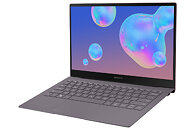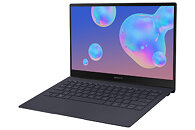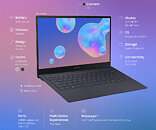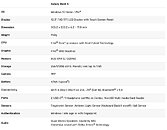Friday, May 29th 2020

Samsung Launches the Galaxy Book S, Featuring Intel "Lakefield"
Samsung Electronics today announced the availability of Galaxy Book S with Intel processor, the latest addition to its leading computing device family. To ensure consumers have access to a wide range of computing devices to best fit their lifestyle, Samsung introduces the Galaxy Book S powered by the new dynamic Intel Core processor with Intel Hybrid Technology. Galaxy Book S joins other previously announced premium mobile laptops, designed to offer a seamless and connected experience across devices. Galaxy Book S is built for the next generation of users who are looking for a computing device that provides outstanding productivity, wide-ranging connectivity, enhanced mobility and expansive continuity across devices and operating systems to help them get more done in less time.
"The way we work has shifted and it's important we have computing devices that can adapt to this new working style. Users utilize multiple devices throughout their day to accomplish tasks, and demand that those devices provide them with enough flexibility to remain on the move and available," said Woncheol Chai, SVP and Head of Product Planning Team, Mobile Communications Business, Samsung Electronics. "With our new computing devices like the Galaxy Book S, we are providing users with an exciting opportunity to be productive, efficient and connected."Dynamic Performance
To improve performance and efficiency, Galaxy Book S features an impressively designed internal component setup powered by the new Intel Core processor with Intel Hybrid Technology. Galaxy Book S is the first ever device to offer this unique processor with Intel's Foveros 3D stacking technology and a hybrid CPU architecture. With this processor, Galaxy Book S efficiently provides an exceptional laptop performance. The processor delivers full Windows 10 application compatibility and intelligently balances multiple high-performing processes during use while conserving battery when not in use, powering your creative, commerce and business programs. Galaxy Book S features a long-lasting battery and offers up to 512 GB of storage, so you don't have to waste time worrying about losing power or running out of space.
"The introduction of Samsung Galaxy Book S, the first device to offer the Intel Core processor with Intel Hybrid Technology, builds on our long history with Samsung. Today, we showcase what can be achieved when we bring great engineering talent together to work towards a united vision for new computing experiences of the future," said Chris Walker, vice president and general manager of Mobile Client Platforms at Intel.
Always Ready Connectivity
With Samsung's new computing devices, you can enjoy nonstop connectivity. Galaxy Book S features Wi-Fi 6 (Gig+), the next generation of Wi-Fi that empowers efficient, speedy internet without competing for a network connection with other devices, while always-on LTE3 lets you enjoy gigabit internet access without searching for a network. When you need to access your device immediately, Galaxy Book S' instant touch-to-wake capability ensures you can reach important files, share videos and respond to texts within seconds.
Design That Works Everywhere
The Galaxy Book S is designed for taking with you and carrying around all day. Lightweight at just 950 g and only 11.8 mm at its thickest point, the ultra-slim profile means you can slip the Galaxy Book S into a small bag, portfolio or just carry under your arm with ease. A fan-less design allows the Galaxy Book S to be slimmer than traditional laptops and helps it to run noiselessly, even during sustained and intense periods of work. Galaxy Book S features a light clamshell design built with a durable metal body, so you can have the stability you need on a desk or on your lap. If you're looking to get some fresh air while scrolling, Outdoor Mode on Galaxy Book S will instantly boost brightness to 600 nits using a two-key shortcut. With a bright screen that also supports touch interactions, you will feel more connected to your device than ever and free take advantage of seamless and productive working style.
Uninterrupted Device-to-Device Continuity
The new Galaxy computing devices like the Galaxy Book S unify the computing experience with seamless connectivity between devices. Thanks to our partnership with Microsoft, you can enjoy your favorite Android operating system on your Windows PC for a seamless and continuous device-to-device experience. With Microsoft's Your Phone feature, you can sync your mobile device to receive notifications, messages, cross-device copy & paste and photo transfer, all on your Galaxy Book S device.
Galaxy Book S is available in two shades, Earthy Gold and Mercury Gray.
"The way we work has shifted and it's important we have computing devices that can adapt to this new working style. Users utilize multiple devices throughout their day to accomplish tasks, and demand that those devices provide them with enough flexibility to remain on the move and available," said Woncheol Chai, SVP and Head of Product Planning Team, Mobile Communications Business, Samsung Electronics. "With our new computing devices like the Galaxy Book S, we are providing users with an exciting opportunity to be productive, efficient and connected."Dynamic Performance
To improve performance and efficiency, Galaxy Book S features an impressively designed internal component setup powered by the new Intel Core processor with Intel Hybrid Technology. Galaxy Book S is the first ever device to offer this unique processor with Intel's Foveros 3D stacking technology and a hybrid CPU architecture. With this processor, Galaxy Book S efficiently provides an exceptional laptop performance. The processor delivers full Windows 10 application compatibility and intelligently balances multiple high-performing processes during use while conserving battery when not in use, powering your creative, commerce and business programs. Galaxy Book S features a long-lasting battery and offers up to 512 GB of storage, so you don't have to waste time worrying about losing power or running out of space.
"The introduction of Samsung Galaxy Book S, the first device to offer the Intel Core processor with Intel Hybrid Technology, builds on our long history with Samsung. Today, we showcase what can be achieved when we bring great engineering talent together to work towards a united vision for new computing experiences of the future," said Chris Walker, vice president and general manager of Mobile Client Platforms at Intel.
Always Ready Connectivity
With Samsung's new computing devices, you can enjoy nonstop connectivity. Galaxy Book S features Wi-Fi 6 (Gig+), the next generation of Wi-Fi that empowers efficient, speedy internet without competing for a network connection with other devices, while always-on LTE3 lets you enjoy gigabit internet access without searching for a network. When you need to access your device immediately, Galaxy Book S' instant touch-to-wake capability ensures you can reach important files, share videos and respond to texts within seconds.
Design That Works Everywhere
The Galaxy Book S is designed for taking with you and carrying around all day. Lightweight at just 950 g and only 11.8 mm at its thickest point, the ultra-slim profile means you can slip the Galaxy Book S into a small bag, portfolio or just carry under your arm with ease. A fan-less design allows the Galaxy Book S to be slimmer than traditional laptops and helps it to run noiselessly, even during sustained and intense periods of work. Galaxy Book S features a light clamshell design built with a durable metal body, so you can have the stability you need on a desk or on your lap. If you're looking to get some fresh air while scrolling, Outdoor Mode on Galaxy Book S will instantly boost brightness to 600 nits using a two-key shortcut. With a bright screen that also supports touch interactions, you will feel more connected to your device than ever and free take advantage of seamless and productive working style.
Uninterrupted Device-to-Device Continuity
The new Galaxy computing devices like the Galaxy Book S unify the computing experience with seamless connectivity between devices. Thanks to our partnership with Microsoft, you can enjoy your favorite Android operating system on your Windows PC for a seamless and continuous device-to-device experience. With Microsoft's Your Phone feature, you can sync your mobile device to receive notifications, messages, cross-device copy & paste and photo transfer, all on your Galaxy Book S device.
Galaxy Book S is available in two shades, Earthy Gold and Mercury Gray.




14 Comments on Samsung Launches the Galaxy Book S, Featuring Intel "Lakefield"
That keyboard looks absolutely horrible, and despite the BIG.little processor choice, there's no word on battery life. My experience of Intel 10nm laptops is not good, currently have a Thinkbook 15 beside me with an i7-1035G7 in it and the battery life is mediocre, probably because it gets really hot, really fast and Windows is forever spooling up the CPU for background tasks.
It's my first real experience of Ice Lake 10nm as previous pool laptops from work have been 8th gen. I'm underwhelmed, no I think I want a 14nm laptop next time. Intel's 10nm is garbage and they should just cancel it to stop wasting everyone's time.
It was bad.
And my friend who worked on the development of that phone said using an Intel chip made his life a miserable hell.
42WH battery will be drained by the screen alone in under 17 hours even if it was possible to somehow power it with a zero-Watt processor.This I can believe. Single-core, in-order pipelines on a general purpose x86 architecture was a terrible idea for smartphones where efficiency and minimal instruction set, streamlined functionality were vital.
Edit:
Looked up what Zenfone used - Z2520. This is a dual-core 4 thread CPU. ARM at the time was predominantly also in-order. General purpose means exactly what it says - general purpose. ARMs are also general purpose CPUs.
IMO x86 is too bloated for a low-power, efficiency-critical application like a smartphone that needs to be always-on.